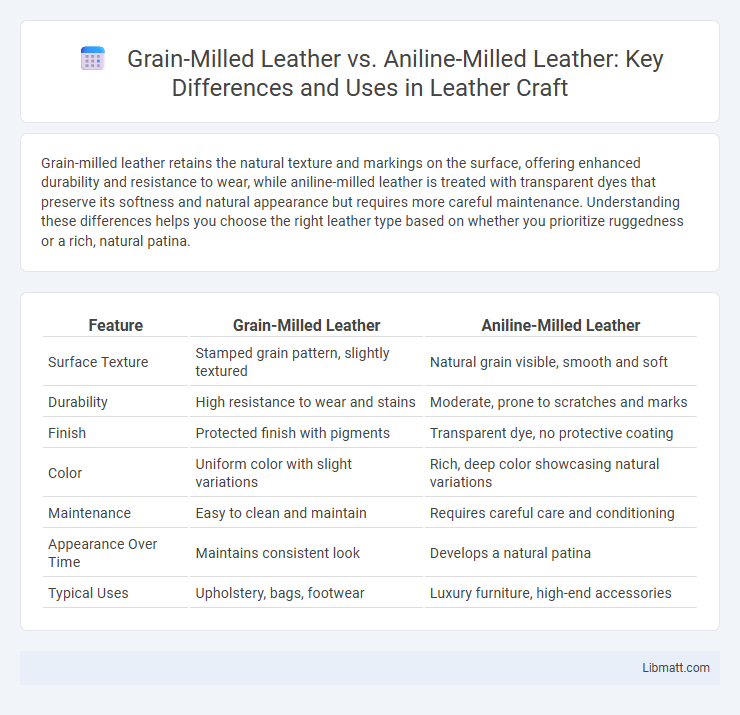Grain-milled leather retains the natural texture and markings on the surface, offering enhanced durability and resistance to wear, while aniline-milled leather is treated with transparent dyes that preserve its softness and natural appearance but requires more careful maintenance. Understanding these differences helps you choose the right leather type based on whether you prioritize ruggedness or a rich, natural patina.
Table of Comparison
| Feature | Grain-Milled Leather | Aniline-Milled Leather |
|---|---|---|
| Surface Texture | Stamped grain pattern, slightly textured | Natural grain visible, smooth and soft |
| Durability | High resistance to wear and stains | Moderate, prone to scratches and marks |
| Finish | Protected finish with pigments | Transparent dye, no protective coating |
| Color | Uniform color with slight variations | Rich, deep color showcasing natural variations |
| Maintenance | Easy to clean and maintain | Requires careful care and conditioning |
| Appearance Over Time | Maintains consistent look | Develops a natural patina |
| Typical Uses | Upholstery, bags, footwear | Luxury furniture, high-end accessories |
Understanding Grain-Milled Leather
Grain-milled leather features a textured surface created through a mechanical milling process that enhances durability and resistance to wear, preserving natural leather characteristics while offering a uniform appearance. This type of leather retains its top grain, providing a balance between strength and flexibility, making it ideal for high-use items like upholstery and footwear. Unlike aniline-milled leather, which is more susceptible to staining due to its lack of protective coatings, grain-milled leather typically includes a protective finish, improving its stain and scratch resistance.
Defining Aniline-Milled Leather
Aniline-milled leather is a type of premium leather dyed with soluble aniline dyes, preserving its natural grain and texture without surface coating. This process results in a supple, breathable material with visible natural markings such as scars and pores, enhancing its unique character. You can expect aniline-milled leather to offer a softer feel and a more authentic look compared to grain-milled leather, which typically undergoes additional surface treatments.
Key Differences Between Grain-Milled and Aniline-Milled Leather
Grain-milled leather features a textured surface created by embossing or stamping, enhancing durability and resistance to wear, while aniline-milled leather maintains its natural grain with minimal surface treatment, offering a softer feel and richer patina over time. Grain-milled leather is often pigmented, providing greater stain and fade resistance, whereas aniline-milled leather relies on transparent dyes that highlight natural imperfections and color variations. The choice between grain-milled and aniline-milled leather impacts longevity, aesthetic appeal, and maintenance requirements, with grain-milled leather favored for rugged use and aniline-milled leather prized for luxury and natural beauty.
Appearance and Texture Comparison
Grain-milled leather displays a textured, pebbled surface resulting from embossing processes that enhance durability and disguise imperfections, offering a rugged yet refined look. Aniline-milled leather preserves the natural hide texture with a smooth, soft surface enriched by translucent dyeing that highlights unique grain patterns and natural marks. The tactile feel of grain-milled leather is generally firmer and more structured, while aniline-milled leather provides a supple, luxurious touch that deepens in patina over time.
Durability: Which Leather Lasts Longer?
Grain-milled leather is known for its superior durability due to its tough, textured surface that resists scratches and wear, making it ideal for high-use items. Aniline-milled leather, while softer and more natural-looking, lacks the protective coating, which makes it more prone to fading and damage over time. For longevity and lasting appearance, your best choice is grain-milled leather, especially if durability is a priority.
Breathability and Comfort
Grain-milled leather features a textured surface that enhances breathability by allowing better air circulation, making it more comfortable for prolonged wear. Aniline-milled leather, treated with transparent dyes and minimal surface coating, retains the natural breathability of the hide but may be less durable. The difference in leather processing impacts moisture absorption and flexibility, where grain-milled often provides superior comfort in warm conditions.
Maintenance and Care Requirements
Grain-milled leather offers higher durability and requires less frequent maintenance due to its protective topcoat, making it resistant to stains and scratches. Aniline-milled leather demands more attentive care, including regular conditioning and avoiding direct sunlight exposure to preserve its natural softness and color. Proper cleaning techniques tailored to each type ensure longevity and maintain the leather's texture and appearance.
Typical Uses in Fashion and Upholstery
Grain-milled leather is commonly used in fashion for durable handbags and jackets due to its textured surface and resistance to wear, while in upholstery, it provides a robust and easy-to-clean finish ideal for high-traffic furniture. Aniline-milled leather, prized for its natural appearance and softness, is frequently chosen for luxury fashion items like high-end shoes and gloves, as well as upscale furniture where a more delicate, supple feel is desired. Your choice between these leathers depends on whether durability or natural aesthetics better suit the intended use.
Pros and Cons of Grain-Milled Leather
Grain-milled leather offers durability and resistance to wear due to its textured surface, making it ideal for daily use and objects that require added protection. The natural grain pattern provides a more rustic, less shiny appearance, but it may be less soft and pliable compared to aniline-milled leather. Your choice depends on whether you prioritize long-lasting strength and scratch resistance over the smooth, luxurious feel of aniline finishes.
Pros and Cons of Aniline-Milled Leather
Aniline-milled leather offers exceptional natural beauty and softness due to its minimal surface coating, allowing the leather's unique grain and texture to remain visible. Your furniture or accessories made from aniline leather will develop a rich patina over time, though it is more susceptible to stains, scratches, and fading compared to grain-milled leather, which usually has protective finishes. While aniline leather provides a luxurious, supple feel, it requires careful maintenance to preserve its appearance and durability.
Grain-milled leather vs aniline-milled leather Infographic

 libmatt.com
libmatt.com